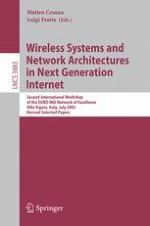2006 | Buch
Wireless Systems and Network Architectures in Next Generation Internet
Second International Workshop of the EURO-NGI Network of Excellence, Villa Vigoni, Italy, July 13-15, 2005, Revised Selected Papers
herausgegeben von: Matteo Cesana, Luigi Fratta
Verlag: Springer Berlin Heidelberg
Buchreihe : Lecture Notes in Computer Science
